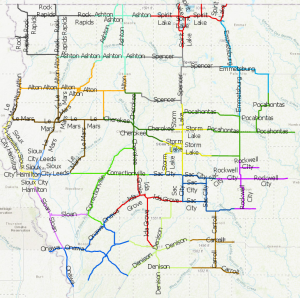InTrans / Dec 02, 2020
Snowplow route optimization offers big potential

The Iowa Department of Transportation (DOT) alone is responsible for servicing 24,000 lane miles of roadways during winter road maintenance operations. Optimizing the current routes used by snowplows has the potential to result in significant cost savings, improved safety and mobility, and reduced environmental and societal impacts.
A recent research project at the Institute for Transportation (InTrans) looked at operations for the Iowa DOT’s District 3, located in northwest Iowa, which services about 4,000 lane miles from 20 depots, to solve two optimization problems that could ultimately expand to other districts and local agencies.
“The methods proposed in this study can be used to generate optimized route designs and sector partitions,” said Jing Dong, principal investigator for the project and transportation engineer at InTrans. “Inefficiencies in current operations might also be discovered by comparing current routes with optimized routes.”
Because the models developed may not represent all local conditions, the routes should be optimized in consultation with a district’s maintenance manager to take into consideration those concerns, Dong added.
“Through this work, we identified a few areas where we could reroute plows to reduce driving distance, or improve plow cycle time,” said Tina Greenfield, the Iowa DOT road weather information system (RWIS) coordinator.
Greenfield added that she expects those changes to be implemented this year.
The project was also noted as a high value research project by the American Association of State Highway and Transportation Officials as part of its Research Advisory Committee’s 2020 Sweet Sixteen and Supplemental Categories awards. The work will also be presented at the 2021 TRB in the “High Value Research Supplemental Projects” session.
The snowplow optimization project designed truck routes for single depots under the District 3 current responsibility map and also designed routes for multiple depots with intermediate facilities. The optimization problems were solved as capacitated arc routing problems (CARPs) using a memetic algorithm (MA) and considering the constraints of road segment service cycle time, heterogeneous vehicle capacities, fleet size, road-vehicle dependency, and work duration.
The results from solving the single-depot optimization problem show a 13.2% reduction in deadhead distance compared to current operations, and the savings could potentially be larger. Deadhead distance is the distance a truck travels while not performing a maintenance service.
For the multiple-depot optimization problem, due to the network structure and current depot locations, the difference between the optimized routes based on a multiple-depot configuration and those based on a single-depot configuration is insignificant.
Though the project focused on snowplows, the route optimization could apply to any vehicles that perform winter maintenance activities, including snow and ice removal as well as the spreading of materials like salt and sand to increase friction and provide anti-icing and de-icing treatments.
More information about the project, including the final report and technology transfer summary, is available here.